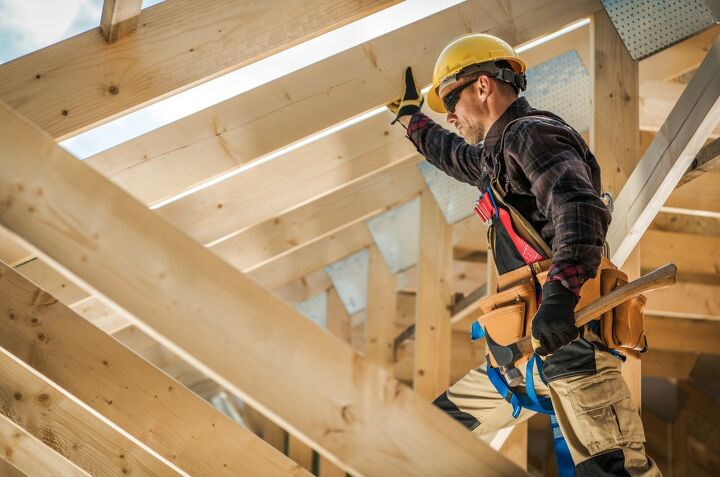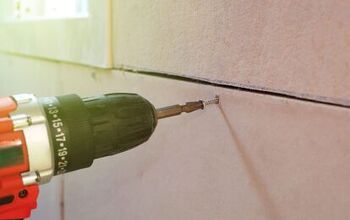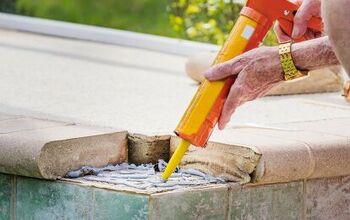What Size Nails For Framing? (Find Out Now!)

Nails are one of the most common fasteners that are used for construction and other projects. At first glance, all nails seem to be created alike, except for the length. Some subtle differences make one type of nail better than another for a specific job, such as framing a structure.
The best nails for framing walls are 16d that measure 3 1/2” in length. Use common nails or sinkers. For your deck framing, use 10d (3”) or 16d stainless steel nails. The best screws for 2×4 framing are 2 1/2” No. 9 screws made from structural steel.
Let’s take a closer look at the most common types of nails and the best designs for framing.
Do You Need to Hire a Framing Contractor?
Get free, zero-commitment quotes from pro contractors near you.

Types of Nails
The eight basic types of nails are finishing, common, roofing, brad, masonry, ring shank, duplex head, and box nails.
- Finishing Nails: Head of the nail is just slightly larger than the body to countersink the nail
- Common Nails: Designed with a thick body, wide head, and pointed tip
- Sinker Nails: Slightly shorter and thinner than common nails
- Roofing Nails: Flat, wide head with a thick body that is ringed or smooth
- Brad Nails: Small finishing nails that are used for woodworking to reduce the risk of splitting
- Masonry Nails: Thick grooved body and wide head made from hardened steel
- Ring Shank Nails: Designed with rings around the body to grip wood flooring and subflooring
- Duplex Head Nails: Made with two heads and used for temporary construction projects, such as concrete forms
- Box Nails: Best for thinner pieces of lumber, trim, and other materials that don’t need structural strength
Nail Sizes
In addition to the right type of nail for the job, you also need to consider the size and material. Nails are sized by measuring the length of the entire nail. You may find nails that are labeled as 12d, 10d, and other references to the penny system. 2d nails are 1” long, and you add another 1/4” for each subsequent step in the system. For example, a 10d nail is 3” long, a 12d nail is 3 1/4” long, and a 16d nail is 3 1/2” long.
Nail Materials
Steel is the best material for nails because it is strong, but it also flexes under force. You can find steel nails that are coated or galvanized. Coatings made from cement or vinyl protect the wood from splitting. Galvanized steel nails are dipped into molten zinc to further strengthen the fastener. Nails are also galvanized with zinc through a process that uses electrical current to bond the zinc to the steel.
Framing Nails vs. Screws
Using nails for your framing job has several advantages over using screws. Framing nails stand up to shearing forces better than screws. When wind, storms, and other situations put pressure against your house, nails will flex. Screws that are used for framing do not flex and snap under the forces on the structure. There are some situations where screws are the better option, such as for deck framing.
What Size Nails for Framing?
The best size nails for framing are 16d framing nails, also labeled as 3.5” framing nails. For some jobs, you can use 12d 3 1/4” sinkers and common nails for framing.
Framing Nails for Treated Lumber
For jobs that require treated lumber, use hot dipped galvanized nails. These types of nails are made of steel and dipped into a bath of molten zinc to strengthen the steel.
What Size Nails for Framing Interior Walls?
When you are framing interior walls, you need a nail that sinks easily into the wood. The best nail for the job is a 16d common or sinker nail. Of these two options, the 16d sinker nail comes out ahead because it is coated with a vinyl cement that helps it cleanly penetrate the wood. The textured head on a sinker nail also makes it ideal for nail guns. The texture helps keep the nail gun in place for precise nail placement.
Nails for Double Wall Studs and Floor Joists
If you are framing an interior wall with double studs or have overlapping joists in your floors, use a 10d nail. These are shorter than 16d sinker nails and the same diameter. The shorter length makes 10d nails perfect for any application where you are joining two flat faces of wood.
What Size Nails for Framing Exterior Walls?
For exterior walls, use a galvanized 16d sinker nail. The body is made of steel for strength, and the galvanized coating prevents rust and corrosion. If the exterior wall is well-protected from the elements, you can used non-coated 16d sinker nails.
What Size Nails for Deck Framing?
When you are building a deck, there are three sizes of nails to use for the job. Framing should be constructed with 3” or 3 1/2” nails. For the railings, use 2”, 2 1/2”, or 3” nails. If you are building the deck platform with 5/4” planks, use 3” or 3 1/4” nails. If the deck boards are 2” planks, use 3 1/2” nails.
What Size Screws for 2×4 Framing?
You can find specialty screws for 2×4 framing, but the cost may be over your budget. Using a hardened steel No. 9 screw with a Philips head to keep the 2×4 boards fixed in place. The screws measure 2 1/2” in length. Check the labeling on the box. You want screws that are designated for structures and decks. Drywall screws are not as strong and snap under forces.
Should You Use 3” Screws for 2×4 Framing?
When you put to 2×4 boards together, the total width is 3”, so why not use a 3” screw? The reason is that drills and drivers sink the screw about 1/2” into the wood. If you use 3” screws for 2×4 framing, the screw comes out the other wide of the wood. The No. 9 screws are the best option.
What Size Nails for a Framing Nailer?
Framing nailers save you time and drive the nails into the wood with precision. Use the same size nail as if you are doing the job without the nailer. The key difference is the angle of the nails. Framing nailers work with framing nails at 15 degrees, 21 degrees, 28 degrees, and 30 degrees.
Framing nails at 15 degrees are best for most framing work, such as wall studs and floor joists. Framing nails that are packaged with higher angle degrees let you work in tighter spaces. Framing nails at 21 degrees are good for interior trim, and framing nails at 30 degrees are good for the smallest spaces in the framing, such as corners.
Related Questions
What size nails should I use for framing a shed?
Use common or sinker nails that are coated with cement or vinyl. These resist the elements and hold the framing together better than uncoated nails.
What is the difference between coil and strip framing nails?
Coil framing nails are packaged at a 15-degree angle for most framing job. Each coil holds 200 to 300 nails. Strip packaging holds fewer nails that are packaged at higher angles for tight spaces.
How do you use a duplex head nail?
Drive the nail into the material until the lower head is flush with the surface. Use the top head to remove the nail from the material.
Do You Need to Hire a Framing Contractor?
Get free, zero-commitment quotes from pro contractors near you.

Summary
There are eight types of nails that are used for construction and other applications. Generally speaking, the best size nails for framing are 3 1/2” 16d common nails or sinkers. Sinker nails are coated with a vinyl cement that helps the nail cleanly and precisely penetrate the wood. For deck framing, nails should be made of galvanized steel that resists corrosion in the elements. Choose a 3” or 3 1/2” nail for the job.
Some people prefer to use screws for framing. The downside is that screws don’t hold up to shear forces as well and snap under pressure. The advantage of using screws for framing is that the fastener is less likely to come loose. For this reason, screws may be the better option for decks, although this depends on how much you use the deck and forces that the deck needs to withstand, such as wind and storms. If you are framing a deck with nails, use 3” to 3 1/2” common nails or sinkers.
When you need to fasten two 2×4 boards for your framing, use 2 1/2” screws. This allows for about 1/2” for sinking by the driver. If you use 3” screws, the end of the nail will come out the other side of the wood.
Nailers are great tools to have on hand for any framing job. Use the same size framing nails as if you are doing the job by hand. You will also need to choose the right angle for the framing nails. Framing nails that are packaged at 15 degrees are good for the majority of the work. Higher degrees in packaging let you work in tighter spaces.

Jennifer L. Eggerton loves being hands-on, whether it's with a home DIY project, making repairs, re-decorating a room, or keeping life organized. She enjoys helping people by sharing her knowledge, insights, and experiences, as well as her lessons learned. In addition to her work as a writer, Jennifer is a Jeep® overlander, self-published author, and nature photographer who loves being outdoors.
More by Jennifer Eggerton



























